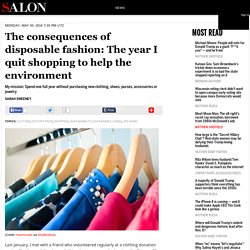

Competition. Diss research. The Hidden Cost of Fast Fashion: Worker Safety. Shoppers have become accustomed to the steady stream of colorful clothing that so-called fast-fashion apparel chains churn out.

Rather than launching lines only at the beginning of each season, chains such as Inditex’s (ITX:SM) Zara and Hennes & Mauritz’s (HMB:SS) H&M introduce styles as often as every two weeks. The constant replenishment keeps fashion-conscious customers coming back for the generally low-priced goods. But worker rights advocates say fast fashion has another, darker cost: Demands for constant product turns may be putting workers’ lives at risk in developing nations such as Bangladesh, which suffered two fatal garment factory fires in as many months. Apparel sold by Spain’s Inditex, the world’s largest apparel company and a pioneer of faster fashion cycles, was found at a factory that caught fire on Jan. 26, killing at least seven people.
Photograph by G.M.B. Surging wages and inflation in China have prompted global retailers to shift production to Bangladesh. How Zara became the world's biggest fashion retailer. This flexibility and efficiency has remained at the heart of Inditex, the company built from Zara that now runs 6,500 shops in 88 different countries and includes seven other brands, including Bershka, Pull & Bear, and Massimo Dutti.

The business model built by Ortega is unique. Zara stores around the world receive deliveries twice a week and products designed at the headquarters in Arteixo reach stores three weeks later. The consequences of disposable fashion: The year I quit shopping to help the environment. Last January, I met with a friend who volunteered regularly at a clothing donation center.

Kari learned the cheap clothing that many people donate – the Forever 21 skirt that cost less than your breakfast, the H&M blouses that never fit quite right, the Zara pants that pilled after one wash – all comes at a devastating cost to the environment. Fast fashion, "value" fashion. Fast fashion, "value" fashion ‘We now buy 40% of all our clothes at value retailers, with just 17% of our clothing budget.’

TNS Worldpanel (2006) Fashion Focus issue 29 A Cambridge University study reports that in 2006, people were buying a third more clothes than they were in 2002, and women have four times as many clothes in their wardrobe than they did in 1980. Women are also getting rid of similar amounts each year. Brands began competing against each other for market share by introducing more lines per year at lower costs, culminating in a situation where ‘fashion houses now offer up to 18 collections a year’ and the low cost, so called ‘value end’ is ‘booming; doubling in size in just 5 years Retailers must respond to quickly changing fashion trends, which now change in weeks instead of months – thanks in part to instant coverage of fashion weeks and street style online.
This naturally has led to pressure on the supply chain. A bit more context…. This had several benefits. Who Are the Fast Fashion Leaders And Why Does It Matter? Recently Sourcing Journal quoted John Thornbeck, chairman of Chainge Capital, that Fast Fashion is the rapid translation of design trends into multi-channel volume.

Fast Fashion may be the most important disrupter in the retail industry today. He also said that disruptive innovations, or product or services, that transform an existing market by introducing simplicity, convenience, accessibility and affordability, have the most positive impact on a company. Zara, Inditex’s leading brand, has been a groundbreaker in bringing new fashions, new designs, and new ideas quickly to its stores. Zara’s relentless push of on-trend merchandise into the supply chain pipeline keeps its stores in stock on the latest fashions at saleable prices. Zara Is the Latest Fast Fashion Retailer to Launch an Eco-Friendly Line. Zara’s owner Amancio Ortega is the second richest man in the world, according to Forbes, with a $67 billion dollar net worth.

And someone who’s made such a killing off a fast fashion clothing brand certainly knows that his wealth doesn’t come without a cost to the environment. Retailers rethink supply chains following Brexit. Fashion on the British high street: the winners and losers. Zara: going up At the top of the game when it comes to fast fashion, Inditex – the group that owns Zara – is just as swift with its thinking.

Its expansion into international markets is serious, with more than a third of its sales this year coming from China and the US, up 29% from a year earlier. Online now accounts for an increasing amount of sales, with 1.3 million people visiting the site every day. Zara's USP is a high turnover of stock that is fashion-aware but never too out there, priced affordably but not cheap as chips. It's a formula that has contributed to Inditex's recent 17% rise in sales figures. Whistles: going up A sleepy high-street brand until Jane Shepherdson took over in 2008, bringing with her a grown-up, minimal-but-feminine aesthetic. John Lewis: going up The grand dame of the British high street has played its traditionalism to its advantage, post the financial crisis. Asos: going up It seems there is no stopping this internet fashion powerhouse.